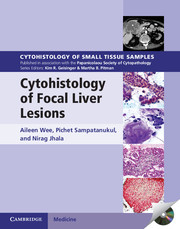Book contents
- Frontmatter
- Dedication
- Contents
- CONTRIBUTING AUTHOR
- Preface
- 1 The focal liver lesion: general considerations
- 2 Morphologic approach
- 3 Diagnostic algorithm
- 4 Focal liver lesions with low or no suspicion of malignancy
- 5 Focal liver lesions suspicious of hepatocellular carcinoma
- 6 Focal liver lesions suspicious of intrahepatic cholangiocarcinoma
- 7 Focal liver lesions from metastases and other malignancies
- 8 Focal liver lesions with cystic appearance
- 9 Focal liver lesions in infants and children
- 10 Ancillary studies
- 11 Techniques and technology in practice
- Index
5 - Focal liver lesions suspicious of hepatocellular carcinoma
Published online by Cambridge University Press: 05 April 2015
- Frontmatter
- Dedication
- Contents
- CONTRIBUTING AUTHOR
- Preface
- 1 The focal liver lesion: general considerations
- 2 Morphologic approach
- 3 Diagnostic algorithm
- 4 Focal liver lesions with low or no suspicion of malignancy
- 5 Focal liver lesions suspicious of hepatocellular carcinoma
- 6 Focal liver lesions suspicious of intrahepatic cholangiocarcinoma
- 7 Focal liver lesions from metastases and other malignancies
- 8 Focal liver lesions with cystic appearance
- 9 Focal liver lesions in infants and children
- 10 Ancillary studies
- 11 Techniques and technology in practice
- Index
Summary
INTRODUCTION
Hepatocellular carcinoma (HCC) is the fifth most common malignancy worldwide and the third leading cause of cancer deaths. The highest rates are in East Asia and sub-Saharan Africa with figures more than five times that of the Western world. Chronic hepatitis B and C virus infections account for 85% of HCC cases, followed by alcohol-induced liver injury. Aflatoxin B1 produced by the molds Aspergillus parasiticus and A. flavus in contaminated grains is an environmental hazard in the tropics. Non-alcoholic steatohepatitis associated with the metabolic syndrome is the newest kid on the block. The major clinical risk factor is cirrhosis and any nodule of any size detected in such a milieu is always a cause for concern. HCCs are well-known heterogeneous tumors with regard to histologic patterns, cell morphology, and differentiation. The World Health Organization (WHO) classification of HCC lists classic type, variants, and special types.
There are guidelines for the diagnosis and management of HCC and related nodules. Due to advances in imaging technology and the perception of certain risks that may be associated with fine needle aspiration biopsy (FNAB)/core needle biopsy (CNB), such as needle tract seeding, preoperative tissue confirmation is not always mandated.
CLASSIC HEPATOCELLULAR CARCINOMA
Clinical perspective
Cirrhosis is not an invariable prerequisite for hepatocarcinogenesis. There are some cases without underlying chronic liver disease and not all types of cirrhosis carry the same high risk for HCC. Focal liver lesions associated with the following clinical settings carry a variable index of suspicion for malignancy, beginning with the highest:
(i) Symptomatic patients who complain of abdominal symptoms or who present with metastatic disease or sequelae of decompensated cirrhosis and portal hypertension.
(ii) Significantly elevated serum α-fetoprotein (AFP) levels or rising trends – although the sensitivity of this tumor marker is low and it is not a good screening tool, about 40% of patients may still present with abnormal serum levels.
(iii) Discovery of focal liver nodules on regular ultrasound surveillance of high-risk patients, such as those with hepatitis B or C cirrhosis; subcentimeter nodules showing interval growth are highly suspect.
(iv) Incidental discovery of focal liver nodule/s of variable size in asymptomatic patients or hepatitis B or C carriers on routine health screening.
- Type
- Chapter
- Information
- Cytohistology of Focal Liver Lesions , pp. 100 - 138Publisher: Cambridge University PressPrint publication year: 2000
- 1
- Cited by

